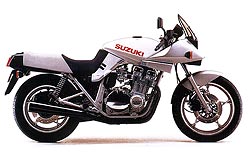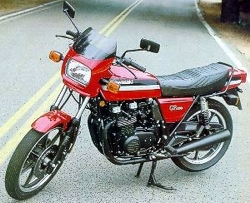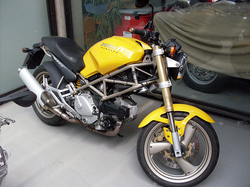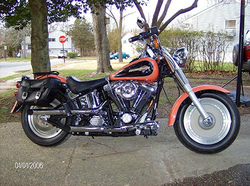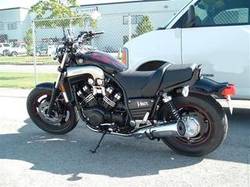(VI) MOTORCYCLE DEVELOPMENT FROM 1980 TO 1999:
The field of motorcycling sees great advances in technology and innovation then a return to a revision of the "retro" look!
The most advanced machines from the last period of time become the new norms. Honda, Yamaha, Suzuki, and Kawasaki develop so many new bikes so fast, the consumer is confused. The competition between them heats up as performance increases at a breathtaking speed. Performance of many street bikes excells race bikes of 10 years earlier. Advancements go beyond the ability of most riders! After the mid 1980's there is a growing market for V-Twin cruisers which grows to become over 40% of the market by the end of the century. Again, Harley Davidson becomes a brand to be recond with showing profits any manufacturer would be envious of.
The 1981 Suzuki Katana was a monster bike:
After 1979 Suzuki produced some serious superbikes still potent to todays standards! The Katanas produced well over 100hp (111 advertised hp) and were seriously fast.
1981 Kawasaki GPz 550:
The little Kawasaki's 550's were significantly faster than to 1970's British 750's. The Japanese manufacturers were building really powerful, sturdy, and reliable bikes. This 550 would still be fast today!
Below is the 1993 Honda CBR900RR:
The Honda Hurricane models became the CBR series in the early 1990's. The CBR900RR advanced the super bike by increasing horse power and reducing weight. The CBR900 ran the quarter mile in around 10.5 seconds and had a top speed around 150mph. Very fast even today. The sport bike category evolved from the Hurricane models.
Ducati becomes a significant player:
Ducati began as a small Itilian manufacturer in the early 1950's. They sold smaller motorcycles in the US during the 1960's and 1970's, but few were seen. In the 1980's they begin making larger bikes and become a major player in international racing circuits. One of their most popular models is the "Monster", a wheelie machine. This model has been offered in 600cc, 750cc, 800cc, 900,cc, & 1000cc versions.
The most significant difference between the 1970's bikes compared to the ones which are offered in the 80's and 90's is that the newer bikes begin to take on farings, water cooled engines, 4 valve per cylinder heads, increasingly exotic suspension systems, and 6 speed transmissions. Japan's grip on the market was solid but big changes were in the making. By the early 1980's the market shrank greatly and the slump left several million unsold Japanese bikes at the dealerships. It was not until the mid 1980's that a larger motorcycle market returned but people no longer wanted 100+ horse power sport bikes but more comfortable cruisers. Within a decade, the most popular bikes would be retro-styled cruisers. By the end of the 1990's, nearly 60% of the market would be cruisers.
The Triumph Trident shown above was offered in Europe in either 750cc or 900cc capacities. In the US, only the 900 was offered.
Key traits of the motorcycle industry during the 80's & 90's:
1. The Japanese motorcycle industry became totally dominant as they continued to develop their machines. Sport bikes pregressively picked up more body work and saw great increases in horse power. They competed against each other and left many riders confused with so many changes over short periods of time;
2. Sales were greatly impacted by two recessions. The 1973 to 1975 recession was the product of a stock market crash in 1973 and 1974 which pushed the unemployment rate to just over 9%. The 1980 to 82 recession was one of skyrocketing inflation of 11 to 13%. This pushed the interest rates up making loans impractical for non essential things like motorcycles. In both time periods motorcycle sales dropped significantly;
3. By the mid 1980's Harley was getting it's act together and was producing much better machines. With the new "Evolution" motor and a much greater concern about quality control, Harley's were becoming more reliable and user friendly. Harley again becomes a significant player for several reasons:
a. Americans wanted to buy American;
b. They sounded really good compared to the Japanese bikes;
c. There was a new interest in all things retro and Harley fit the bill;
d. Dealerships were becoming more "spruced up" and less intimidating to the consumer;
e. The "foot forward" seating was comfortable and fit the larger, heavier American;
4. Ducati begins building competitive sport bikes (the 851) and builds a larger dealer network;
5. Triumph returns and develops a competitive line of motorcycles;
6. As the 1990's progress, bikes begin to fall into several specific categoties. The price point is generally more important than the size ot the bike. What used to be 250/350/500/650/750/1000/1400cc categories slowly become: Naked, Sport, Sport Touring, Cruiser, & Touring. There have always been different sizes of bikes and general categories, but as never before, specific categories became more pronounced.
By the end of the 1980's and more stronly in the 1990's, the Japanese manufacturers began building V-Twin cruisers. Harley had returned from their depressed years building retro-styled bikes and America liked them! Now everyone was cashing in on the new trend.
Below is an early 1990's Honda Ace.
